Mis Abuela: Culinary Heritage and Modern Adaptations
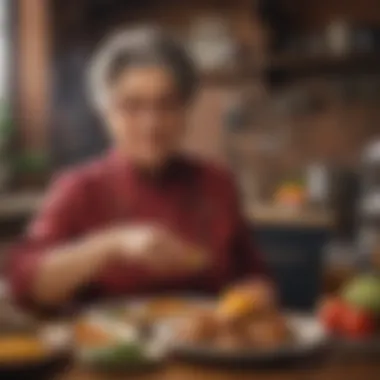

Intro
The culinary landscape is rich, varied and deeply rooted in tradition. Central to many traditions is the role of grandmothers, or 'mis abuela.' These matriarchs often serve as the custodians of family recipes and cooking techniques. Their kitchens are not just places for meal preparation but also spaces where stories are shared, and cultures are transmitted through generations. The phrase 'mis abuela' evokes memories of warmth, comfort, and the unique tastes that characterize family gatherings.
This article explores the multifaceted influence of grandmothers in shaping culinary identity. It examines how they preserve age-old recipes while also allowing for adaptations that reflect contemporary tastes and health trends. As we delve into this topic, we will uncover the timeless significance of these culinary guardians and their impact on the modern kitchen.
In light of globalization, the culinary heritage passed down from generation to generation faces new challenges and opportunities. We will analyze the balance between maintaining traditional recipes and the myriad of modern adaptations that have emerged in today's diverse culinary world. By doing this, we engage with the ongoing narrative of food, culture, and identity that continues to evolve.
Recipe Overview
- Recipe Name: Abuela's Classic Guiso
- Description of the Dish: This hearty stew is a beloved family recipe that offers a glimpse into the rustic and rich flavors of traditional cooking. Guiso, often made with various meats and vegetables, serves as a reminder of family gatherings where everyone comes together to share a meal and stories of the past.
Ingredients
- 2 pounds of beef, cubed
- 4 medium potatoes, diced
- 2 carrots, sliced
- 1 onion, chopped
- 3 cloves of garlic, minced
- 4 cups of beef broth
- 2 tablespoons of olive oil
- 1 teaspoon of salt
- 1/2 teaspoon of black pepper
- 2 bay leaves
- Optional: 1 cup of green beans for added freshness
Special Notes on Ingredients
- For a healthier version, consider using lean cuts of beef or substituting with chicken.
- Regional variations may include the addition of local herbs or spices, depending on cultural influences.
"Cooking is a matter of the heart, echoing the love that grandmothers pour into every meal."
As we continue our journey through culinary heritage, it is essential to recognize the personal narratives embedded within each recipe. Cooking practices may evolve, but the essence of sharing meals and the connections they forge remains unchanged.
The Concept of Mis Abuela in Culinary Context
The culinary phrase "mis abuela" captures a profound sentiment that transcends mere food preparation. It embodies a legacy encompassing knowledge, tradition, and the deep-rooted emotional ties associated with family cooking. This section aims to explore the essence of this concept, surveying its importance in contemporary culinary practices.
Defining Mis Abuela
"Mis abuela" literally translates to "my grandmother" in English. However, its implications are much richer. This expression is a nostalgic nod to traditional cooking that often evokes memories of childhood and familial gatherings. Grandmothers serve as the custodians of recipes that are often passed down through generations. Each dish they prepare tells a story and encapsulates a family’s history and cultural background.
In essence, mis abuela represents not just the food but also the experiences and wisdom shared through cooking. Every recipe holds a piece of history, often meticulously recorded in handwritten notes or stored in the depths of family memories. As they share these recipes, grandmothers teach much more than just cooking techniques. They impart values, reinforce family bonds, and cultivate traditions that give a sense of identity to the next generation.
Cultural Significance of Grandmothers
Grandmothers occupy a unique position in many cultures around the world. They are often seen as sources of wisdom and guidance. In culinary contexts, their role is amplified as they conserve the culinary traditions that define cultural heritages.
The significance of grandmothers extends beyond individual families. They represent a link between past and present. Through their cooking, they maintain a connection to ancestral customs and cultural narratives. This can be particularly important in societies facing rapid changes due to globalization.
In many cultures, grandmothers are seen as the main providers of sustenance. They are revered not only for their culinary skills but also for their ability to foster community connections. Grandmothers often bring families together over a shared meal, making their presence essential in both festive and everyday settings.
"Cooking is like love. It should be entered into with abandon or not at all."
In summary, the concept of mis abuela in culinary contexts embodies much more than recipes and ingredients. It serves as a vital channel of cultural transmission. By understanding this dynamic, we can appreciate the depth that grandmothers provide to our culinary experiences.
Historical Perspective on Culinary Practices
Understanding the historical perspective on culinary practices is essential for appreciating the depth of . This historical lens provides context to how culinary traditions were born, evolved, and adapted through generations. It illuminates the significance of grandmothers as custodians of culture and culinary knowledge, revealing the intricate tapestry that connects family recipes to broader societal influences. By delving into the past, we can grasp the nuances of ingredients, techniques, and the very essence of flavors that have come to define heritage cooking.
Traditional Cooking Techniques
Traditional cooking techniques are the backbone of culinary heritage. These methods, often passed down from grandmother to granddaughter or grandson, showcase the skills and artistry that go into preparing meals. For instance, techniques such as sautéing, braising, and fermenting are not merely ways to cook; they are expressions of culture and history.
- Sautéing: This technique involves cooking food quickly in a small amount of oil or fat. It allows the ingredients’ flavors to meld together and is common across many cuisines.
- Braising: A slow-cooking method that combines both wet and dry heat, braising reflects a tradition of patience, allowing flavors to develop fully.
- Fermenting: This ancient technique has been used for centuries to preserve food. It's an excellent example of utilizing natural processes to enhance flavor and nutrition.
With these techniques, grandmothers not only teach practical skills but also impart wisdom about timing, temperature, and the importance of using fresh, high-quality ingredients. Each method carries stories, cultural significance, and an invitation to connect with one’s roots.
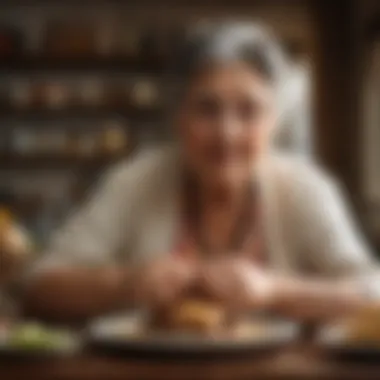

Ingredients and Their Origins
Ingredients are the building blocks of any recipe. Understanding their origins adds another layer to the culinary narrative. Many ingredients have deep historical and cultural stories tied to specific regions. For example, the use of corn in Mexican cuisine reflects the agricultural practices of ancient civilizations, which revered maize.
- Heirloom Varieties: These ingredients are often neglected in modern cooking. Heirloom tomatoes, for instance, are cherished for their distinct flavors and are often linked back to specific localities.
- Spices: Spices such as saffron, cinnamon, and cumin have traveled across continents, each bringing unique flavors and practices from their origins.
- Local Produce: Using seasonal and local produce not only connects dishes to their geographical roots but also emphasizes sustainability.
Knowing where ingredients come from not only adds depth to the cooking process but also fosters a sense of stewardship for culinary traditions.
"Food is not merely a means of survival; it connects us with our ancestry, our geography, and our environment."
In summary, examining the historical aspects of culinary practices enriches our understanding of . It showcases how traditional cooking techniques and ingredient origins shape the culinary landscape we navigate today. By recognizing these influences, we acknowledge the rich tapestry of flavors, cultures, and stories entwined in each meal.
Family Recipes: A Legacy Passed Down
Family recipes hold a unique place in culinary heritage. They go beyond just providing food; they encapsulate memories, traditions, and cultural identities. In the context of mis abuela, these recipes often represent the culinary wisdom passed down through generations. Each dish carries a story, a connection to the past, and a means of fostering family bonds. As modernity reshapes eating habits, the significance of these recipes becomes even more crucial. They are a link to our roots, grounding us in our cultural identities even as we adapt our practices to contemporary needs.
Documenting Family Recipes
Documenting family recipes is an essential practice. It ensures that the culinary knowledge does not fade away with time. Often, grandmothers are the first to introduce children to cooking. Many family recipes are prepared through a trial-and-error process rather than written instructions. This can lead to important culinary methods being lost.
To combat this, families can take steps to capture these culinary traditions. Writing down the recipes while learning improves retention and creates a family cookbook. Digital means also allow for easier sharing and preserving. One can consider creating a family blog or a shared folder online where everyone can contribute. This practice not only aids in preservation but also builds a sense of community around cherished traditions.
The Role of Oral Tradition
The role of oral tradition in passing down family recipes is significant. Many cooks learn by watching and listening, absorbing techniques and stories without written guides. This method fosters a connection between generations. When grandmothers teach their grandchildren, it is not merely about the food; it transcends into life lessons and cultural values.
Stories often accompany the recipes. They convey not only how to cook but also why each ingredient matters. This oral transmission keeps the spirit of the cuisine alive, evolving with each generation. It is a living history that integrates personal experiences with collective family memory.
In summary, family recipes embody more than just flavors; they encapsulate wisdom, relationships, and cultural identity. Documenting these recipes and relying on oral tradition are essential acts of preservation, ensuring that the culinary legacies connected to mis abuela continue to thrive.
Modern Adaptations of Traditional Recipes
The landscape of culinary practices is continually shifting. Traditional recipes, often handed down through generations, remain a core aspect of family identity and cultural heritage. Yet, in today's fast-paced world, modern adaptations of these recipes hold significant importance. These adaptations serve to maintain relevancy and increase accessibility for wider audiences, ensuring that culinary legacies do not fade away into obscurity.
Embracing modern cooking techniques and available ingredients can lead to exciting outcomes. The growing focus on sustainability and health awareness prompts many cooks to reimagine their beloved family recipes. This evolution includes altering ingredient choices and cooking methods while still capturing the essence of the original dishes. By doing so, culinary traditions are not only preserved but also revitalized for contemporary palates.
Fusion Cuisine: Blending Flavors
Fusion cuisine is a powerful representation of modern adaptations. It involves combining elements from multiple culinary traditions to create innovative dishes that surprise and delight. This practice respects the essence of each culture while introducing novel flavors and textures. It is not just about mixing ingredients; it’s about understanding the culinary principles that define each tradition.
For example, consider a dish like Korean Tacos, which combine traditional Mexican tacos with Korean bulgogi. This combination appeals to diverse tastes and fosters appreciation for different cultures in a single meal. Blending flavors from various backgrounds enables cooks to innovate while honoring their roots. While some purists may resist these adaptations, many find that they enhance the overall dialogue between different cuisines.
As chefs and home cooks continue to experiment, fusion cuisine encourages culinary exploration and creativity, fostering a sense of community among food enthusiasts.
Health-Conscious Modifications
Health-conscious modifications represent another angle of modern adaptations. In recent times, there has been an increased awareness of dietary restrictions and the importance of nutrition. Recipes that once relied heavily on rich, high-calorie ingredients are undergoing significant transformations.
For instance, creamy sauces may be replaced with lighter alternatives such as yogurt or cashew cream. Additionally, whole grains can take the place of refined grains, and vegetables are often featured more prominently in new renditions of traditional dishes. These changes not only cater to health-conscious individuals but also introduce the potential for new flavor profiles and textures.
"Modern adaptations allow opportunities for creativity while respecting tradition."
Moreover, these modifications often help in making heritage recipes more inclusive for different dietary preferences, including vegetarianism, veganism, or gluten-free diets. By prioritizing health, cooks ensure that family recipes continue to find a place in today’s culinary landscape, proving that tradition and modernity can coexist harmoniously.
Grandmothers as Culinary Educators
Grandmothers hold a unique position in the culinary world. They are not just family matriarchs but also vital educators, instilling the love of cooking and the importance of culinary heritage in the younger generations. Their hands are the ones which have sown the seeds of traditional recipes, ensuring that these practices continue to thrive even as modern culinary landscapes evolve. Grandmothers act as the link between past and present, helping to shape a more defined culinary identity within families and cultures.
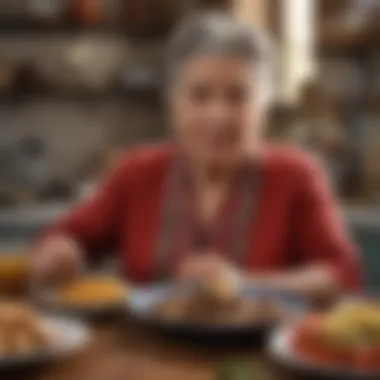
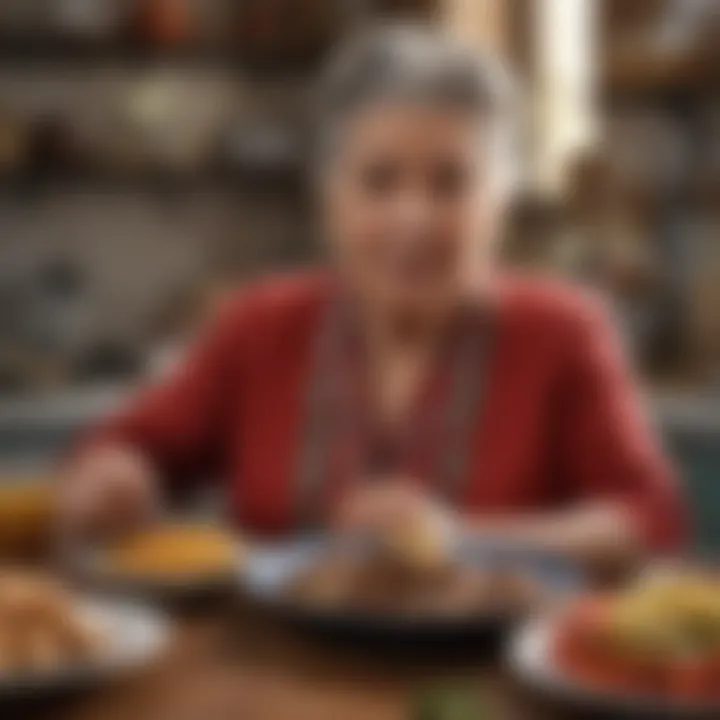
The role of grandmothers as educators presents several benefits. First, they impart valuable cooking techniques. Through practical, hands-on experience, grandchildren learn foundational skills that are essential in the kitchen. They are taught how to properly knead dough, fold a delicate pastry, or simmer a rich broth. The teaching is often informal and immersive. This facilitates a relaxed and organic learning environment.
Moreover, grandmothers encourage creativity and experimentation. They foster a sense of confidence in the kitchen, allowing their grandchildren to explore flavors and mix ingredients in ways that suit their personal tastes. This not only preserves traditional methods but also enables modern adaptations.
"Culinary education starts at home, with grandmothers passing down not just recipes but core values related to food."
Educators also play a critical role in preserving family recipes. Each dish often comes with its own story, connecting family history to cultural practice. As such, every meal cooked becomes a lesson in legacy. This connection transforms cooking into an act of remembrance, one where recipes serve as relics of culinary heritage.
Teaching Cooking Techniques
Grandmothers excel at teaching age-old cooking techniques. Their expertise is often acquired through years of practice, rooted in generations of culinary arts. Techniques passed down might include knife skills, marinating methods, or slow-cooking processes, which can deeply enhance the flavor profile of dishes.
When teaching these skills, grandmothers usually focus on the science behind cooking as well. They explain the why behind certain steps. For example, understanding the importance of resting dough before baking can lead to better texture and flavor in the final product. Such knowledge sets the groundwork for culinary education that goes beyond mere recipe memorization.
Influencing the Next Generation
The influence of grandmothers extends beyond mere cooking techniques. Their approach to food embodies values such as sharing, nurturing, and community. This cultural transmission plays a crucial role in shaping dietary habits and lifestyle choices. When grandchildren cook alongside their grandmothers, they learn the importance of fresh ingredients, seasonality, and sustainability.
This education fosters a sense of responsibility toward food. The younger generation often becomes more aware of where their food comes from and how it is prepared. Grandmothers also create an environment of love and warmth around meal preparation, which builds strong family bonds.
In essence, grandmothers serve as culinary educators, enriching the knowledge base of their families while ensuring that the customs and values tied to food remain intact. For many, these lessons form the bedrock of their culinary identity. This generational influence shapes not only their understanding of food but also contributes to the rich tapestry of cultural diversity in culinary practices.
Technology and the Evolution of Traditional Cooking
Technology has been a significant player in transforming how we approach cooking, particularly regarding traditional methods passed down through generations. The intersection of these technologies and culinary practices opens new avenues for preserving heritage while adapting to modern demands. Grandmothers, often the gatekeepers of family recipes, find themselves in a unique position. They can blend their traditional skills with modern innovations to enhance the cooking experience.
As cooking becomes more accessible due to advancing technology, the essence of these time-honored practices does not fade. Instead, it evolves. From smart kitchen appliances to educational apps, this evolution assists in maintaining culinary heritage while making it adaptable for younger generations. The use of technology, therefore, complements the mission of preserving family recipes, ensuring they remain relevant.
Online Recipe Sharing Platforms
Online recipe sharing platforms have grown immensely popular in recent years. Websites like AllRecipes and food blogs serve as repositories for countless recipes, often contributed by home cooks worldwide. Grandmothers contribute by sharing their family recipes, gaining visibility in a vast digital cookery network. These platforms allow for the cross-pollination of ideas. A traditional dish can trigger discussions that enhance or adapt the original, introducing new flavors and techniques.
Benefits of these platforms include:
- Accessibility: Anyone can access traditional recipes, regardless of location.
- Community Engagement: Users can share their cooking experiences or variations of family recipes.
- Preservation of Heritage: Digitalization of recipes helps ensure they do not vanish.
Moreover, these platforms allow for multimedia content. Video tutorials, for instance, can demystify complicated cooking techniques. This is especially relevant for traditional dishes that may require intricate skills passed down verbally through generations.
Impact of Social Media on Culinary Traditions
Social media has a powerful role in shaping culinary customs today. Platforms like Instagram and TikTok showcase cooking as a visual art form. The influence of social media extends to how traditional dishes are perceived and recreated. Techniques once confined to a grandmother's kitchen can now be seen, adapted, and applauded globally.
Social media facilitates:
- Widespread Sharing: Recipes can go viral, reaching vast audiences and sparking interest in traditional cooking.
- Culinary Challenges: Users often participate in cooking challenges that encourage them to recreate traditional dishes, fostering a sense of connection.
- Hybrid Cuisine: The blending of different culinary traditions is promoted, as users experiment with new ingredients while keeping traditional flavors alive.
"Social media transforms our understanding of tradition, allowing old habits to thrive in new contexts."
This blending not only respects the traditional recipes but also reshapes them to fit contemporary tastes and nutritional needs. Grandmothers can become influencers in this space, inviting a new generation to appreciate and adapt their culinary legacy in profound ways.
Culinary Trends Inspired by Grandmothers
The influence of grandmothers in the kitchen extends far beyond simple family meals. These culinary matriarchs not only preserve traditional recipes but also inspire modern cooking trends. The importance of this topic lies in understanding how character and history shaped many current culinary practices. By reflecting on the contributions of our ancestral cooks, we can appreciate life lessons in flavors, sustainability, and health that have become increasingly relevant in today's culinary dialogue.
Revival of Heirloom Ingredients
Heirloom ingredients are often overlooked in contemporary cooking. However, many of these ingredients have rich histories and unique flavors. Grandmothers often utilized what was locally available or what they had preserved from their gardens. This practice revives a connection to food origins and promotes biodiversity.
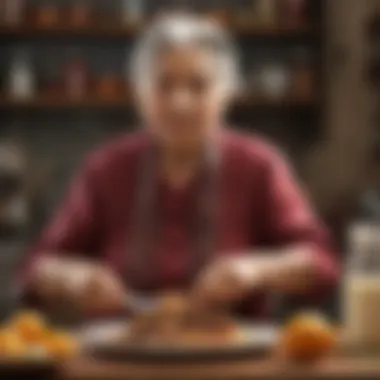

Heirloom varieties of fruits, vegetables, and grains stand out due to their distinct tastes and nutritional profiles. They are not manipulated for uniformity, unlike many mass-produced varieties. The resurgence of these ingredients encourages chefs to explore flavors that have been forgotten or neglected.
Using heirloom ingredients also has ecological advantages. By focusing on endangered crop varieties, we can support small farmers and maintain genetic diversity. This not only sustains our environment, but enriches our plates as well. As more people learn about these ingredients’ heritage, they can incorporate them into their cooking, bridging the past with the present.
Emphasis on Sustainable Cooking Practices
Sustainability in cooking is crucial as we face environmental challenges. Many grandmothers embraced sustainability through frugality and ingenuity. They often prepared meals that used every part of an ingredient, resulting in minimal waste. This approach is increasingly relevant in today’s world, where zero waste initiatives are gaining traction.
Sustainable cooking practices prioritized seasonality and local sourcing. Grandmothers taught the importance of eating what is in season and preserving its freshness. This practice not only supports local agriculture but also fosters awareness of food's journey from farm to table.
Some sustainable practices include:
- Preservation Techniques: Canning, pickling, and fermenting extend the life of food, echoing traditional methods.
- Plant-Based Meals: Many grandmothers cooked meals that incorporated more vegetables and legumes, promoting health and sustainability.
- Community Engagement: Involving a community, be it through local markets or community gardens, builds connections and highlights the importance of sharing resources.
Overall, culinary trends inspired by grandmothers reveal not just a return to roots, but a commitment to a healthier and more sustainable future. As we recognize their influence on modern cooking, we celebrate an enduring legacy that blends historical wisdom with contemporary practices.
Cultural Exchange Through Cooking
The act of cooking extends beyond mere nourishment; it serves as a conduit for cultural exchange. This section explores the significance of culinary practices as a means of sharing traditions, history, and identity across different communities and regions. When families gather around a table, they are not just sharing meals but also stories and legacies of their ancestors. This exchange reinforces communal bonds and fosters a deep appreciation for diverse culinary heritages.
Global Influence of Traditional Recipes
Traditional recipes often travel far from their origins, influenced by migration and globalization. The adaptation of family recipes helps maintain a connection to cultural roots while introducing new flavors and techniques.
- Heritage and Identity: Many cultures have unique dishes that reflect their history, using ingredients that are locally sourced and seasonally appropriate. For example, Italian risotto, Mexican mole, or Japanese sushi are not just about food but represent complex traditions.
- Adaptation and Fusion: With globalization, traditional recipes may evolve. Cultural exchange allows for the infusion of local ingredients or methods. A classic Italian pasta can be reimagined with Asian spices, showcasing how culinary identities can adapt and thrive.
- Preservation: Traditional recipes hold significant value. They are often passed down through generations, safeguarding unique cooking methods that might otherwise fade away. Efforts to document these recipes ensure that cultural identities remain vibrant.
Cross-Cultural Cooking Innovations
As the world becomes increasingly interconnected, cross-cultural cooking innovations emerge. These culinary inventions arise when chefs and home cooks experiment by merging various culinary traditions. This not only results in new flavors but also promotes understanding and respect among diverse culinary styles.
- Creativity in Cooking: Blending techniques and ingredients from different cultures allows for creative culinary expressions. For instance, a Korean taco combines Korean flavors with the traditional Mexican tortilla, which represents a fusion of cultural narratives.
- Collaborative Cooking Events: Events such as food festivals or pop-up restaurants often celebrate cross-cultural cuisine. They encourage collaboration between chefs from different backgrounds, fostering an environment of creativity. Such interactions contribute to the culinary landscape, drawing food lovers closer.
- Community Engagement: Shared cooking experiences promote cultural awareness. Workshops that showcase how to prepare foreign dishes enable participants to learn about the community behind them. Cooking together encourages dialogue and exchange, breaking down cultural barriers.
"Culinary exchange is not just about food; it’s about connecting people and stories across the globe."
Culmination: The Enduring Legacy of Mis Abuela
The culinary legacy rooted in the phrase "mis abuela" is a testimony to the influence and wisdom of grandmothers in our kitchens. Their role extends beyond mere recipe sharing; it embodies the essence of preserving cultural identity through food.
Firstly, the act of cooking is often intertwined with memory and emotion. Grandmothers serve as custodians of culinary traditions, passing down knowledge crafted through years of experience. This imparting of wisdom fosters a strong sense of belonging and continuity in families. The recipes they have mastered are not just meals but snapshots of history, connecting generations through flavors and stories. Keeping these traditions alive ensures that the fabric of cultural identity is preserved, enriching our collective heritage.
Food is also an important medium for conversations and family gatherings. The table, laden with dishes crafted from family recipes, becomes a space for connection. Grandmothers teach their grandchildren about their roots, cultural significance of certain ingredients, and the origins of recipes. In doing so, they reinforce familial bonds and facilitate an understanding of cultural norms.
Moreover, the legacy of mis abuela encourages innovation within the kitchen. As culinary landscapes shift, there is a need to adapt. Grandmothers inspire new generations to take traditional recipes and interpret them through modern lenses. This evolution facilitates a dialogue between the past and the present, allowing each generation to leave their mark.
"To preserve culinary heritage is to honor the past while embracing the future."
Importance of Preserving Culinary Heritage
Preserving culinary heritage is paramount for a number of reasons. First, it ensures that recipes, techniques, and flavors tied to specific cultures are not lost. This loss can lead to a homogenization of food, stripping away the unique characteristics that define a region's cuisine. Continuously passing down traditions keeps these culinary identities vibrant and relevant.
Additionally, culinary heritage serves as a capsule of history. Each dish tells a story, reflecting the journey of a community through agriculture, trade, and migration. This historical context is crucial as it provides insights into societal shifts and cultural exchanges.
Families can also benefit from preserving culinary heritage, as it fosters a sense of pride and belonging. Sharing recipes can strengthen intergenerational ties, allowing families to bond over cooking experiences that are rich with tradition. It can also inspire an appreciation for the efforts of those who came before us, deepening one's respect for their heritage.
A Call for Continued Exploration of Family Recipes
There is a growing need for exploration and documentation of family recipes. This not only helps in preserving culinary traditions but also encourages creativity in the kitchen. Recipes can be inspired by older generations while incorporating contemporary ingredients or techniques.
Encouraging individuals to write down their family recipes and share them within their communities is essential. Platforms for sharing should be promoted, allowing for the safe passage and evolution of culinary heritage. In the digital age, social media can also play a significant role. People can post about their family dishes, creating a wider network of shared experiences.
Continued exploration means engaging with local markets to understand ingredient origins and supporting local farmers, which can further enrich the cooking experience. It also inspires mindful cooking, embracing sustainability.
Ultimately, the legacy of mis abuela will thrive as long as there is interest in maintaining and evolving these cherished culinary traditions. Each dish cooked today offers a glimpse into the past and sets a future direction. It is fundamental for each of us to take part in this journey, ensuring that our culinary heritage is preserved, celebrated, and continuously explored.







